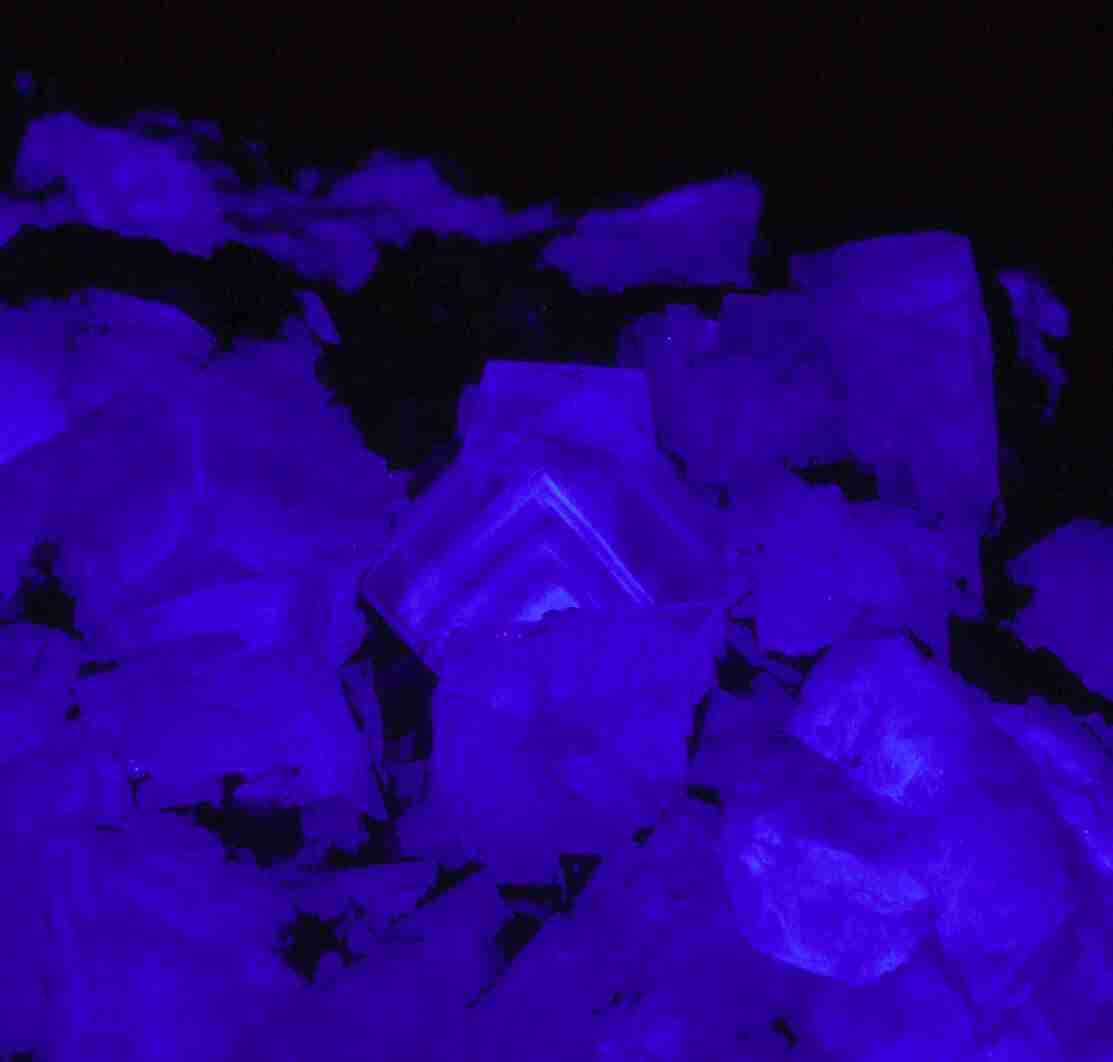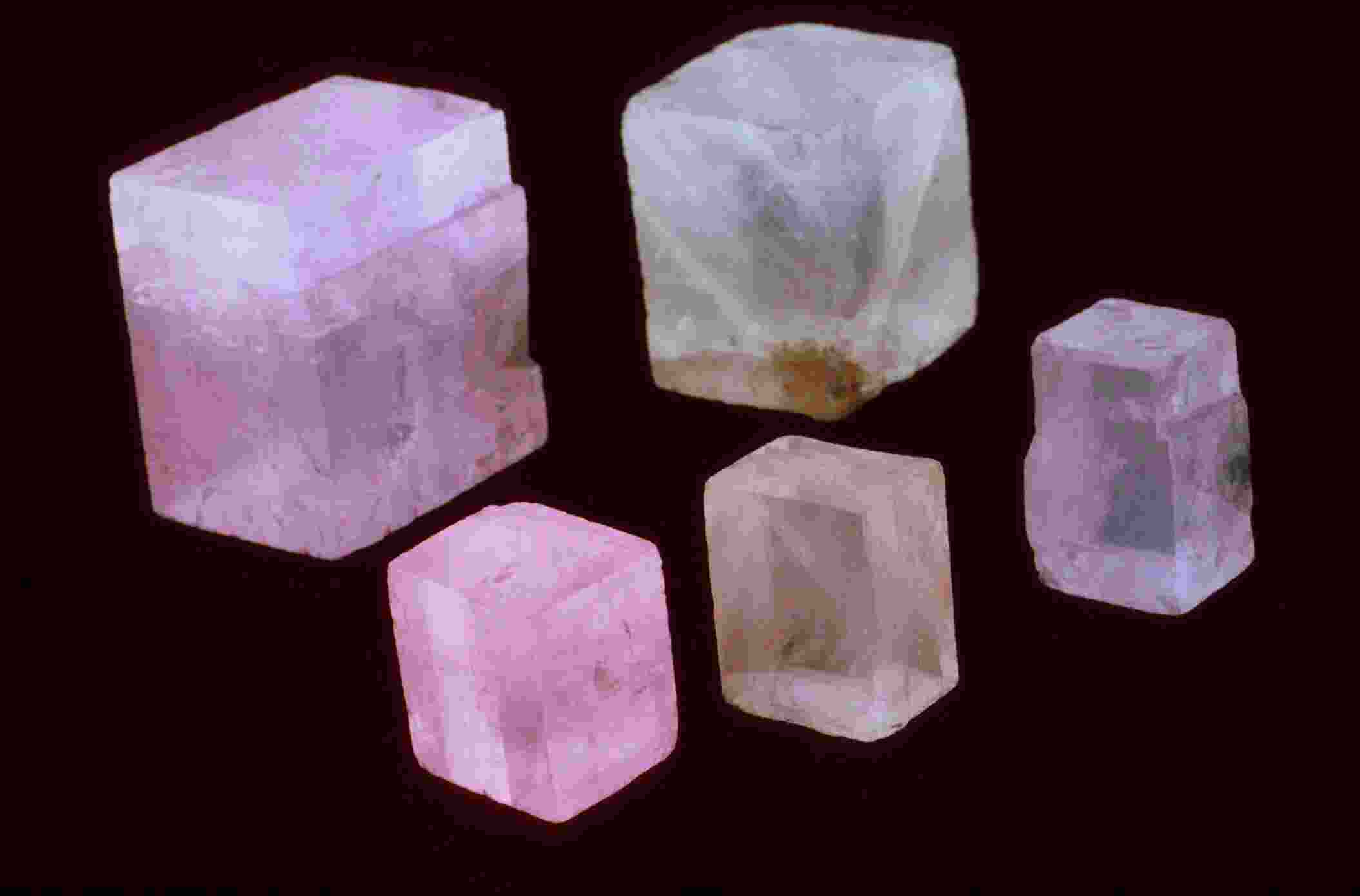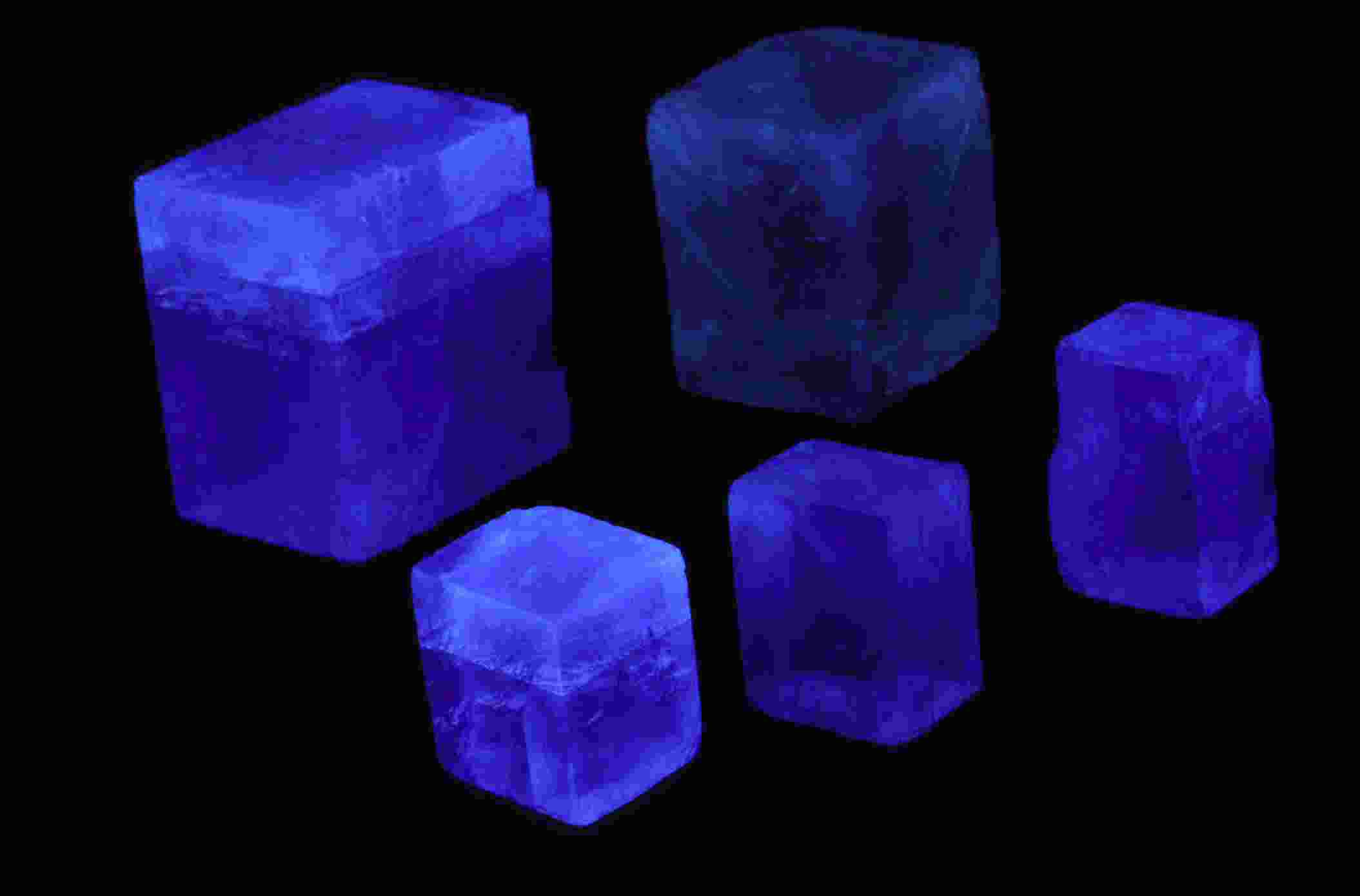ARTSHOP: Fluorescent Prints | "Thermal Expansion" Paintings | Toutenfluo Art | Gallery Prints | Museum Prints | Toutenfluo Prints |
CD-Roms | Ordering Information







"Fluorescent Mineral Viewing
Box" - White light (left) / Longwave U.V. (middle)
/ Shortwave U.V. (right)
"ELECTRIC LADYLAND - the First Museum of Fluorescent Art"
FLUORESCENT MINERAL
DEMONSTRATIONS
Demonstrations of Fluorescent Minerals and Fluorescent
Mineral Artwork from the 1950Žs are given with separate hand-held
Long Wave U.V. and Short Wave U.V. portable lamps in
a tall glass display case, and on a "Bolder Area" with large pieces of
Fluorescent Minerals to touch, including a 30 kilo piece
of Calcite and Willemite from Franklin, New Jersey,
which is the "Fluorescent Mineral Capital of the World."
About fifteen percent of all known minerals are "Fluorescent
Minerals." These are minerals that emit colors when put under
an Ultraviolet lamp. When certain substances, like
Fluorescent Minerals or Fluorescent Paint, are put under an Ultraviolet
lamp, the Ultraviolet energy excites "Activator" atoms
in the substances and causes a movement of their electrons to a
higher orbit. When the excited electron moves back
to it's original orbit, it gives off most of the energy it received from
the
Ultraviolet lamp as Visible Light - Colors - this is
known as "Electron Displacement."
There are also different intensities of Ultraviolet energy.
The most common, weakest, and harmless Ultraviolet is
Longwave Ultraviolet, which people know through "Black
Lights." Longwave Ultraviolet is not only harmless
to the eyes and skin, but is actually essential to plant
growth, as well.
Shortwave Ultraviolet is very powerful and is used only
in science fields, like Mineralogy and Astronomy.
This energy does not reach the surface of the Earth
because it is blocked by the Ozone layer, but as far as
Fluorescent Minerals are concerned, many more minerals
Fluoresce under Shortwave Ultraviolet than under Longwave U.V.
In between the Longwave and the Shortwave U.V. is Middlewave
Ultraviolet, which is widely known through sun-tan salons.
The most powerful Ultraviolet is Extreme Ultraviolet.
Stronger than Shortwave U.V., this Ultraviolet also never reaches
the surface of the Earth. Extreme Ultraviolet collides
with Oxygen atoms in the upper atmosphere and recombines into the
Ozone layer, forming a natural 'U.V. block' keeping all
of the Shortwave, and most of the Middlewave Ultraviolet
from reaching the Earth.
FLUORESCENT MINERAL DISPLAY CASE
:


TOP SHELF: Fluorescent
Mineral Artwork from the 1950Žs-
This is a sculpture made by a Japanese man named "Miera"
who lived in northern New Jersey.›
It is his masterpiece and last Fluorescent Mineral Artwork,
which took six months to make.
› First it is shown under under Long Wave U.V., then
Short Wave U.V., and then under both
the Long Wave U.V. and the Short Wave U.V. together,
the way it was intended to be seen.




Terlingua, Texas Calcite - White light / Longwave U.V / Shortwave U.V. / Phosphorescence
SHELF TWO: Terlingua,
Texas Calcite-
Demonstrations are given of the Color Change of the mineral
from the Long Wave U.V. lamp to the Short Wave U.V. lamp,
and then by gently waving the Short Wave U.V. lampblack
and forth over the 13 specimens, the mineral is seen constantly
Changing Color from Pink to Blue.? Phosphorescence can
be seen in many different intensities and shades of color
after the Short Wave U.V. lamp is turned off. Terlingua,
Texas Calcite is one of the most amazing and world famous of all
the Fluorescent Minerals. The Phosphorescence is
the longest recorded of any known Fluorescent Mineral.
When the Shortwave U.V. lamp is turned off, these crystals
have ben recorded to give off Phosphorescence up to 18 years
in the dark. Your eyes can see the bright White
/ Blue Phosphorescence for up to about an hour maximum, but the
Terlingua, Texas Calcite crystals continue to Phosphoresce
by giving off tiny particles of Light, called "Quanta"
of Light for up to 18 years! Terlingua, texas Calcite
also displays a very rare Fluorescent Mineral phenomenon called
"Irreversible Photosensitivity". When crystals
of Terlingua, texas calcite came out of the mine they were a Greenish Gray,
but when they were exposed to sunlight the Greenish Gray
daylight color turned to Pink forever.
Nothing can be done to turn the crystals back to their
original Greenish Gray, it is a permanent change on the atomic
level. Just a few reasons why Terlingua, Texas
Calcite is one of the most famous Fluorescent Minerals on the planet.


Fluorescent Phantom Crystal - Fluorite, England - White light (left) / Longwave U.V. - Phantom Crystal (right)
SHELF THREE: Fluorescent
Crystals and Special Pieces-
Many different crystals are seen under first the Long
Wave U.V. lamp, then the Short Wave U.V. lamp, including
"Phantom Crystals," drill-core samples from mines in
Franklin, and Sterling Hill, New Jersey, a piece of cement from the
original Sterling Hill Mine building which is filled
with Fluorescent Calcite and Willemite, "Mylonitized" ore from Sterling
Hill,
and a specimen from the Himalaya with two Fluorescent
Minerals in it.



Rhombohedral Calcite - Mexico - White light (left) / Longwave U.V. (middle) / Shortwave U.V. (right)
SHELF FOUR:
Fluorescent Minerals that Change Color from Long Wave U.V. to Short Wave
U.V.-
Nine different kinds of Fluorescent Minerals can be seen
Changing Color from the Long Wave U.V. to the Short Wave U.V.,
including Microcline from the Himalaya, Sodalite and
many pieces of Tugtupite from Greenland, Rhombohedral Calcite
from Mexico, Chalcendony from Spain, Aragonite from Sicily,
Terlingua, Texas Calcite, Willemite from Arizona,
and Fluorite from Gilgit, Pakistan.




Terlingua, Texas Calcite - White light / Longwave U.V. / Shortwave U.V. / Phosphorescence
SHELF FIVE: Phosphorescent
Minerals-
Many different Fluorescent Minerals are shown Phosphorescing
separately under first Long Wave U.V.,
then under Short Wave U.V., including "Radiating" Willemite
from Franklin, Aragonite from Sicily,
Selenite from Chadciz, Poland, and a crystal of Adverdissen
from Weserbergland, Germany.
› Two-Color Phosphorescence can be seen in Terlingua,
Texas Calcite, "Black" Sphalerite from Franklin,
a piece of Calcite and Fluorite from Spain, and Sphalerite
from Sterling Hill Mine, Ogdensburg, New Jersey.
The Fluorescent Mineral Demonstration
continues with four more Phenomenon of Light:
Tenebrescence (Reversible
Photosensitivity)
The most amazing Geological phenomenon that is Demonstrated
in "Electric Ladyland - the First Museum of Fluorescent Art"
is a very rare Mineralogical occurrence known as "Tenebrescence".
Some specimens of very plain or colorless Hackmanite,
a variety of Sodalite, can be capable of an astounding
Change of Colors. In the Museum, Demonstrations of Tenebrescence
are given on a piece of Green Hackmanite from Greenland,
and Gray Hackmanite from Norway. These two specimens are
very plain spinach Green and gray when I take them out
for the Demonstration, then a Shortwave U.V. lamp is placed on top
of the two spinach Green and Gray Hackmanite specimens
for ten seconds. When the Shortwave U.V. lamp is removed
from the two Hackmanite specimens, the spinach Green
and Gray Hackmanite areas of both the specimens have been
mystically transformed into bright Purple / Magenta!
Like I tell the Museum visitors staring in astonishment at the
transformed Purple / Magenta rocks, this is what they
used to call "Magic".
Irreversible Photosensitivity
›› When Terlingua, Texas Calcite is mined it is a greenish
color, but after exposure to sunlight it turns a pink color permanently
.› This is the opposite of Tenebrescence, where the change
in color can be made an endless amount of times.
› A specimen that has never been exposed to Sunlight,
and is still Greenish, is shown next to a typical Pink specimen.
"Non Linear" Fluorescence
›› Two large pieces of "Black" Sphalerite, which came
out of a mine in Franklin, New Jersey in the early 1800`s,
are shown first with the Long Wave U.V. lamp held close
to the minerals, then with the lamps held a meter away
from the minerals, to demonstrate the Change in Color
of the Fluorescent Sphalerite from the different
amounts of energy it receives.
Triboluminescence
›› A piece of Sphalerite from Balmat, New York is gently
rubbed with a paper clip in the dark,
and yellow/apricot light can be seen that is created
inside the mineral, from the friction of the rubbing paper clip.
› These are not sparks, because when another area of
the stone is rubbed, it is shown that no light is created -
only when an area of the stone that is Sphalerite is
rubbed with the paper clip, is Color seen.?
The yellow/apricot light can even be produced in the
Sphalerite by just rubbing it with your fingernail.